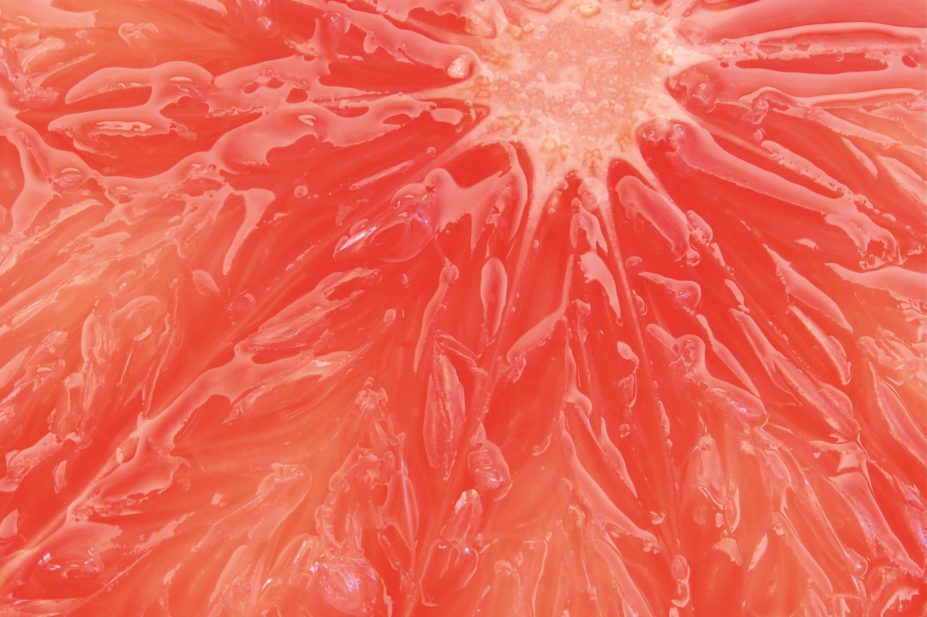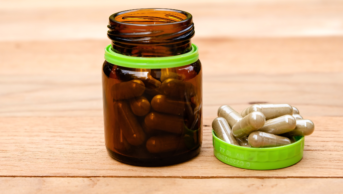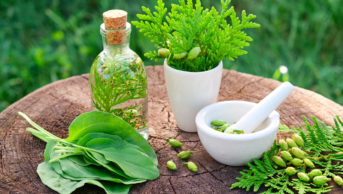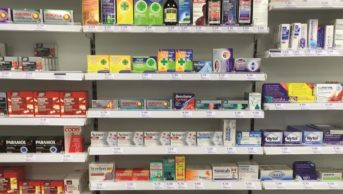
Adam Ward / Dreamstime.com
In this article you will learn:
- Why fruit juices interact with certain medicines
- Common medicines that interact with grapefruit juice
- The latest advice on fruit juice for patients taking warfarin
Many fruits and fruit juices, in particular citrus juices, can affect the metabolism of medicines. Interactions have been documented with apple, cranberry, grapefruit, orange, pomegranate, pomelo and purple grape juices.
However, while the area has been subject to much research, it is often hard to predict whether an interaction will occur with a particular fruit product. This is because the concentrations of the natural compounds in the juice vary between different varieties of fruit and can be affected by environmental conditions, such as the climate where the fruit is grown.
The profile of compounds in citrus juice can also be affected by commercial juicing procedures. For example, mechanical pressing increases contact between the peel and the pith of the fruit, which have a much higher concentration of naringin than the juice vesicles. Compounds can also be affected by turning the juice into a concentrate[1]
.
This article is not an exhaustive list of all fruit juice and drug interactions. Further interactions are available in Stockley’s Drug Interactions.
Causes of interactions
Fruit juices contain several pharmacologically active compounds. These include flavonoids (such as naringin and hesperidin) and furanocoumarins (such as bergamottin and 6’,7’-dihydroxybergamottin). It is not certain which compounds are responsible for interacting with medicines.
Cytochrome P450 enzymes (CYP) can be inhibited by fruit juices. Naringin, which is metabolised to naringenin, is known to inhibit the isoenzyme CYP3A4. Bergamottin and 6’,7’–dihydroxybergamottin can also cause CYP3A4 inhibition.
Grapefruit juice is known to be a weak inhibitor of CYP3A4 and is therefore expected to increase the exposure of medicines metabolised by CYP3A4. However, the variability between different grapefruit juice products means its effects on medicines can be unpredictable.
Grapefruit juice exerts the majority of its inhibitory effect on CYP3A4 in the intestine, but has minimal effect on hepatic CYP3A4. This means drinking grapefruit juice does not substantially affect the exposure of medicines metabolised by CYP3A4 if they are given intravenously. Grapefruit juice has the greatest effect on drugs that have poor oral bioavailability, such as felodipine (see ‘Common grapefruit juice interactions’).
P-glycoproteins are thought to be inhibited by furanocoumarins. P-glycoprotein is an efflux pump (responsible for moving substances out of the cell) found in some cell membranes.
P-glycoprotein in the cells of the gastrointestinal wall can eject some already-absorbed medicines (e.g. fexofenadine) back into the intestine, so its inhibition increases the patient’s overall exposure to affected medicines.
Organic anion-transporting polypeptides (OATPs) can be inhibited by juices including grapefruit, apple and orange juice. These are membrane transport proteins responsible for substance uptake, for example through the gastrointestinal wall. This inhibition will decrease the absorption of affected medicines[2]
.
Do whole fruits interact?
Patients taking medicines that interact with fruit juices may ask whether they should avoid the fruit itself.
Studies have shown that consuming grapefruit pulp, grapefruit segments, or grapefruit segment-free extract can increase a patient’s exposure, as measured by the area under the concentration-time curve (AUC), to nifedipine and nisoldipine by 30%, and results in a threefold increase in exposure to felodipine[3], [4]
. However, a case study found that ingestion of a grapefruit (300g) before taking either amlodipine or nifedipine had no effect on the plasma concentration of either drug[5]
.
Until more is known, pharmacists should advise patients to avoid the whole fruit if there is evidence its juice can interact with their medicine.
Common grapefruit juice interactions
| Interaction | Management |
|---|---|
| Source: Stockley’s Drug Interactions | |
Amiodarone
| Grapefruit juice inhibits the metabolism of oral amiodarone. This is an established interaction, although the clinical consequences are still unclear. The US and UK manufacturers recommend that grapefruit juice should be avoided when patients are taking oral amiodarone. |
Calcium channel blockers | Grapefruit juice moderately increases felodipine exposure. This is an established interaction and concurrent use is contraindicated. Patients taking felodipine should not eat whole grapefruit. Studies suggest that grapefruit juice and calcium-channel blockers other than felodipine and possibly nifedipine can be used concurrently. However, pharmacists should check the diet of any patient who complains of increased or excessive adverse effects with any calcium channel blocker. |
Statins
| Grapefruit juice has been shown to increase simvastatin exposure when large amounts are taken at the same time. On the basis of the available data, simvastatin should not be taken simultaneously with grapefruit juice. The interaction can be minimised, but not eliminated, if simvastatin is taken in the evening (as recommended), and a small quantity of grapefruit juice is consumed at breakfast. However, concurrent use is still not recommended. Grapefruit juice moderately increases atorvastatin exposure, but the interaction seems less likely to be clinically relevant than that with simvastatin. The UK manufacturer suggests that large quantities of grapefruit juice (more than 1.2 litres daily) are not recommended. In general, the occasional glass of grapefruit juice would not appear to be a problem. Grapefruit juice is not known to interact with fluvastatin, rosuvastatin or pravastatin. |
Ciclosporin | Grapefruit juice can increase ciclosporin exposure. This is an established interaction that is clinically important. Patients taking ciclosporin should be warned not to drink grapefruit juice, as increased ciclosporin concentrations are associated with nephrotoxicity. A study has also shown that ciclosporin concentrations can be reduced if taken with purple grape juice, which the study authors suggest is possibly due to the juice affecting ciclosporin absorption[6] |
Although the causes of fruit juice interactions have not been determined conclusively, studies have investigated fruit juice interactions in several commonly prescribed medicines to determine their effects.
Sildenafil
Sildenafil is predominantly metabolised by CYP3A4 and has only moderate oral bioavailability. Nevertheless, it appears that its absorption is not increased significantly by grapefruit juice in most patients.
In one study, 250ml of grapefruit juice was given to healthy subjects one hour before and together with a 50mg dose of sildenafil. The area under the concentration-time curve (AUC) for sildenafil, a measure of overall exposure, was increased slightly (by 23%), and the maximum plasma concentration was not changed significantly[7]
.
However, a case report has described one patient who experienced a 168% increase in the AUC for sildenafil after taking a single 25mg dose of sildenafil with 250ml of grapefruit juice[8]
.
The minor pharmacokinetic interaction of grapefruit juice with sildenafil is unlikely to be clinically important in most patients. Nevertheless, the combination should be avoided. Patients who decide to drink grapefruit juice while taking sildenafil should be told to be alert for adverse effects (e.g. headache, flushing, hypotension) and avoid drinking grapefruit juice if these occur.
Pomelo fruits are related to grapefruits, but appear to have the opposite effect on sildenafil metabolism. In a crossover study, when healthy subjects took a single 50mg dose of sildenafil with 250ml of pomelo (Citrus grandis) juice, the maximum plasma concentrations and AUC were reduced by 37% and 40% respectively when compared with sildenafil plus water[9]
.
This finding was unexpected, particularly because pomelo juice increases the bioavailability of ciclosporin, another medicine metabolised by CYP3A4. This means other mechanisms of interaction could be involved and, until more is known, patients should be advised that sildenafil might be less effective if taken with pomelo juice.
Fexofenadine
Fexofenadine is transported by both P-glycoprotein and OATPs, and changes in their function can affect fexofenadine uptake. In particular, OATPs are inhibited by grapefruit juice, apple juice and orange juice, potentially reducing the absorption of fexofenadine[10]
.
One study found that 300ml of normal strength grapefruit juice reduced the AUC of a single 120mg dose of fexofenadine by 42%, and 1.2 litres of grapefruit juice was found to reduce the AUC by 64%[11]
.
Similarly, another study in 10 healthy subjects consuming 1.2 litres of juice found that grapefruit juice at normal strength decreased the AUC of a single 120mg dose of fexofenadine by 67%, while dilute grapefruit juice caused a smaller reduction of 23%. Normal strength orange juice and apple juice also decreased the AUC of fexofenadine, by 72% and 77%, respectively[10]
.
The amounts of fruit juice consumed in these two studies were quite large, and the effect on fexofenadine exposure might not be as great for patients only drinking a small amount.
Further study is required to determine the clinical relevance, if any, of the reduction in fexofenadine bioavailability in the presence of grapefruit juice, orange juice and apple juice. Patients taking fexofenadine do not need to avoid fruit juices. However, pharmacists should consider this interaction as a possible cause if treatment seems less effective than expected.
Aliskiren
Studies have shown that small amounts of apple, grapefruit and orange juices can have a sizeable effect on aliskiren exposure and concentrations. It therefore seems likely that concurrent use might reduce the blood pressure lowering effects of aliskiren.
In a randomised, crossover study, 11 healthy people were given 200ml of grapefruit juice three times a day for five days, with a single 150mg dose of aliskiren on day three. Grapefruit juice reduced the maximum plasma concentration and AUC of aliskiren by 81% and 61%, respectively[12]
. Another study repeated the experiment, with 12 healthy people drinking 200ml of apple juice, orange juice or water three times daily for five days, with a single 150mg dose of aliskiren on day three. Apple juice reduced maximum plasma concentration and AUC by 84% and 63%, respectively, while orange juice reduced maximum plasma concentration and AUC by 80% and 62%, respectively[13]
.
The exact mechanisms for these interactions are unclear. The UK manufacturer of aliskiren suggests that the interaction is likely to be due to an inhibition of OATP-mediated uptake of aliskiren in the gastrointestinal tract. Consequently, fruit juices should not be taken with aliskiren because of the risk that treatment may not be effective.
Warfarin
In 2004, the Committee on Safety of Medicines (CSM) of the Medicines and Healthcare products Regulatory Agency (MHRA) advised that patients taking warfarin should avoid drinking cranberry juice unless the health benefits were considered to outweigh any risks. The CSM also recommended increased international normalised ratio (INR) monitoring for any patient taking warfarin who has a regular intake of cranberry juice, and similar precautions with other cranberry products (such as capsules or concentrates). This precaution was based upon a number of case reports that suggested cranberry juice increased the INR of patients taking warfarin, and had resulted in the death of one patient from gastrointestinal and pericardial bleeding[14]
.
The mechanism by which cranberry juice and warfarin interact is not known. It has been suggested that cranberry juice might inhibit the activity of CYP2C9, by which warfarin is metabolised, thereby reducing its clearance from the body and increasing its effects[15]
. However, in five controlled studies carried out since the CSM warning, cranberry juice or cranberry extracts have not been found to alter the pharmacokinetics of warfarin, and cranberry juice had no effect on the pharmacokinetics of flurbiprofen, a drug used as a surrogate index of CYP2C9 activity[16]
. It has been suggested that an interaction might be taking place through a pharmacodynamic mechanism; for example, salicylates in commercial cranberry juice might cause hypoprothrombinaemia[17]
.
Currently, the manufacturers of warfarin suggest avoiding cranberry products or increasing the supervision and INR monitoring for patients wishing to take warfarin and cranberry. However, the controlled studies now available do provide some reassurance that, in otherwise healthy individuals, moderate doses of cranberry juice are unlikely to have an important impact on anticoagulation control.
Case reports also suggest that pomegranate juice might increase the INR in patients taking warfarin. Pomegranate juice has been shown to be an inhibitor of CYP2C9, the main isoenzyme involved in the metabolism of the more active S-isomer of warfarin, in
vitro
[18]
. It is therefore possible that pomegranate juice decreases warfarin metabolism, increasing its concentration and effects. However, the evidence is limited to isolated case reports and controlled studies are required to confirm an interaction. Pharmacists should consider pomegranate juice consumption in a patient with otherwise unexplained increase in INR or fluctuations of INR.
This article has been produced by Stephanie Jones, Claire Preston, and Harpreet Sandhu on behalf of the Stockley’s Drug Interactions editorial team. The book is available in print through Pharmaceutical Press or electronically with quarterly updates through MedicinesComplete.
This article was amended on 10 October to clarify that simvastatin should not be taken with grapefruit juice even if simvastatin is taken in the evening and grapefruit juice is consumed in the morning.
References
[1] Ameer B & Weintraub RA. Drug Interactions with Grapefruit Juice. Clin Pharmacokinetics 1997;2:103–121.
[2] Dolton MJ, Roufogalis BD & McLachlan AJ. Fruit juices as perpetrators of drug interactions: the role of organic anion-transporting polypeptides. Clin Pharmacol Ther 2012;92:622–630.
[3] Ohtani M, Kawabata S, Kariya S et al . Effect of grapefruit pulp on the pharmacokinetics of the dihydropyridine calcium antagonists nifedipine and nisoldipine. Yakugaku Zasshi 2002;22:323–329.
[4] Bailey DG, Dresser GK, Kreeft JH et al. Grapefruit-felodipine interaction: effect of unprocessed fruit and probable active ingredients. Clin Pharmacol Ther 2000;68:468–477.
[5] Nakagawa K & Goto T. Effects of ingestion of grapefruit juice or grapefruit on the hypotensive effect and plasma concentrations of dihydropyridine calcium antagonists (amlodipine and nifedipine): a case study. Clin Exp Hypertens 2010;32:71–75.
[6] Oliveira-Freitas VL, Dalla Costa T et al. Influence of purple grape juice in cyclosporine bioavailability. J Ren Nutr 2010;20:309–313.
[7] Jetter A, Kinzig-Schippers M, Walchner-Bonjean M et al. Effects of grapefruit juice on the pharmacokinetics of sildenafil. Clin Pharmacol Ther 2002;71:21–29.
[8] Sheu MT, Wu AB, Yeh GC et al. Development of a liquid chromatographic method for bioanalytical applications with sildenafil. J Chromatogr B Analyt Technol Biomed Life Sci 2003;791:255–262.
[9] Al-Ghazawi MA, Tutunji MS, AbuRuz SM. The effects of pummelo juice on pharmacokinetics of sildenafil in healthy adult male Jordanian volunteers. Eur J Clin Pharmacol 2010;66:159–163.
[10] Dresser GK, Bailey DG, Leake BF, et al. Fruit juices inhibit organic anion transporting polypeptide–mediated drug uptake to decrease the oral availability of fexofenadine. Clin Pharmacol Ther 2002;71:11–20.
[11] Dresser GK, Kim RB, Bailey DG. Effect of grapefruit juice volume on the reduction of fexofenadine bioavailability: possible role of organic anion transporting polypeptides. Clin Pharmacol Ther 2005;77:170–177.
[12] Tapaninen T, Neuvonen PJ & Niemi M. Grapefruit juice greatly reduces the plasma concentrations of the OATP2B1 and CYP3A4 substrate aliskiren. Clin Pharmacol Ther 2010;88:339–342.
[13] Tapaninen T, Neuvonen PJ & Niemi M. Orange and apple juice greatly reduce the plasma concentrations of the OATP2B1 substrate aliskiren. Br J Clin Pharmacol 2011;71:718–726.
[14] Griffiths AP, Beddall A & Pegler S. Fatal haemopericardium and gastrointestinal haemorrhage due to possible interaction of cranberry juice with warfarin. J R Soc Promot Health 2008;128:324–326.
[15] Committee on Safety of Medicines/Medicines and Healthcare products Regulatory Agency. Possible interaction between warfarin and cranberry juice. Current Problems 2003;29:28.
[16] Greenblatt DJ, von Moltke LL, Perloff ES et al. Interaction of flurbiprofen with cranberry juice, grape juice, tea, and fluconazole: in vitro and clinical studies. Clin Pharmacol Ther 2006;79:125–133.
[17] Isele H. Tödliche Blutung unter Warfarin plus Preiselbeersaft. Liegt’s an der Salizylsäure? MMW Fortschr Med 2004;146:13.
[18] Nagata M, Hidaka M, Sekiya H et al. Effects of pomegranate juice on human cytochrome P450 2C9 and tolbutamide pharmacokinetics in rats. Drug Metab Dispos 2007;35:302–307.


